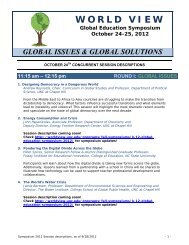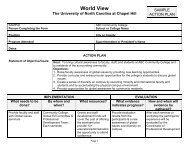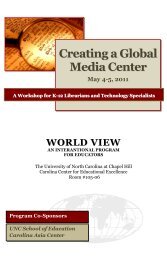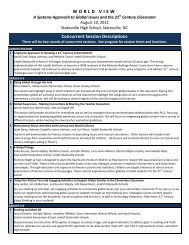North Carolina Gateway to the World - World View
North Carolina Gateway to the World - World View
North Carolina Gateway to the World - World View
Create successful ePaper yourself
Turn your PDF publications into a flip-book with our unique Google optimized e-Paper software.
<strong>North</strong> <strong>Carolina</strong><strong>Gateway</strong> <strong>to</strong> <strong>the</strong> <strong>World</strong><strong>World</strong> <strong>View</strong> 2012 Community College Symposium UNCChapel Hill, Nov 14, 2012<strong>North</strong> <strong>Carolina</strong> : <strong>Gateway</strong> <strong>to</strong><strong>the</strong> <strong>World</strong>PresentedbyRaleigh Bailey, Ph.D.Direc<strong>to</strong>r, UNCG Center for New <strong>North</strong> CaroliniansWith Assistance from Khem Khatiwada and Ghaisha Yahaya-MuhammedAmeriCorps ACCESS Members, UNCG- CNNC
15,000 years ago: <strong>the</strong> first Americans1600’s: Colonial era, first Europeans and Africans1700’s and beyond: secondary migration<strong>North</strong> <strong>Carolina</strong>’sImmigrant His<strong>to</strong>ry<strong>World</strong> War II and beyond:• Creation of United Nations and UNHCR• Migrant Workers: Growing Latino population• 1965 Immigration Reform Act• Vietnam War aftermath• Refugee Resettlement Act of 1980• Development of Ethnic Enclaves• 1986 Immigration Reform and Control Act• 1990’s Economic Boom and Globalization• 1996 Illegal Immigration Reform and ImmigrantResponsibility Act
Why People Migrate<strong>to</strong> <strong>the</strong> United StatesFamily reunifications and relativesEmployment opportunitiesRefugees and asyleesNon-immigrants: students, <strong>to</strong>urists,temporary workers…
The Refugee Process Refugees are resettled through nationally approved resettlementagencies under contract with <strong>the</strong> U.S. Department of State and<strong>the</strong>ir regional affiliates. Follow up services are provided through contracts with <strong>the</strong> federalOffice of Refugee Resettlement (ORR) and <strong>the</strong> State level through<strong>the</strong> Office of <strong>the</strong> State Refugee Coordina<strong>to</strong>r with <strong>the</strong> NCDHHSDSS. NC has 8 resettlement agencies with 10 offices. Activities arefocused on <strong>the</strong> Triad, Charlotte, and <strong>the</strong> Triangle with someresettlement in Craven and Buncombe counties.
The Refugee ProcessContinued In an average year, NC resettles about 2000 refugees, concentratedin <strong>the</strong> in <strong>the</strong> Triad, Charlotte, and <strong>the</strong> Triangle NC ranks as <strong>the</strong> 10 th largest State in <strong>the</strong> number of refugeesresettled annually. It is considered a model state in “success” of <strong>the</strong>refugees here. Refugees may petition <strong>to</strong> become LPR’s after a year and requestresettlement of family members.
NC Hispanic/LatinoGrowth 800, 000 Latinos in NC Represents 25% of NC’s growth in <strong>the</strong> last 20 years Represents 8.4% of NC population Latinos have grown by 111% in last ten years Native births have now overtaken migration NC is <strong>the</strong> 11 th largest State in terms of Latino population 61% are from Mexico; 13% from Central America; followed byo<strong>the</strong>r smaller %s Latinos are in all NC counties but <strong>the</strong> largest populations are in: Mecklenburg: 112,000 Durham: 36,000 Wake: 88,000 Guilford: 35,000 Forsy<strong>the</strong>: 42,000 Cumberland: 30,000
Secondary Migrants A term used <strong>to</strong> depict people, particularly immigrants moving from onepart of <strong>the</strong> U.S. <strong>to</strong> ano<strong>the</strong>r. This becomes a major part of demographics asnewcomers move within <strong>the</strong> country, trying <strong>to</strong> find <strong>the</strong> best fit andsupportive community. In NC, <strong>the</strong> Hmong tribal people from Laos came as refugees after <strong>the</strong>Vietnam War, have picked NC as a major secondary migration site, withclose <strong>to</strong> 15,000 people living in Western Piedmont, Hickory, and Morgan<strong>to</strong>nareas. This makes NC <strong>the</strong> 4 th largest Hmong settlement State. Most of <strong>the</strong>seHmong moved here from o<strong>the</strong>r States. Ano<strong>the</strong>r example is Russian and Ukrainian populations in <strong>the</strong> Ashevillearea, most of <strong>the</strong>m coming as secondary migrants. O<strong>the</strong>r cities have smallclusters building on <strong>the</strong> “Ethnic enclave” process.
Newcomer ImmigrationStatus Newcomers, non U.S. citizens, may have various types of statuswhen <strong>the</strong>y come <strong>to</strong> <strong>the</strong> U.S. The system is complex, confusing, and broken. However, below aresome of <strong>the</strong> common categories. International visi<strong>to</strong>r-temporary visa (not classified as immigrant) International student Out of status, undocumented, “illegal”. Temporary work visa Employment visa: might eventually lead <strong>to</strong> LPR Status Refugee or asylee (someone who meets UNHCR and DOS definitions of fleeingwar or oppression and accepted <strong>to</strong> U.S.) After a year, this can transition <strong>to</strong> LPR.
Legal PermanentResident (LPR) Also known as “Green Card” holder even though <strong>the</strong> card is notgreen: goal for newcomers who want <strong>to</strong> eventually transition <strong>to</strong>becoming a U.S. citizen. After 5 years as an LPR, with good moral character, meetingphysical presence and residency requirements, a person mayinitiate <strong>the</strong> citizenship application. S/he must be at least 18 yearsof age and successfully pass <strong>the</strong> U.S. citizenship test. An estimated 70,000 <strong>to</strong> 80,000 NC LPR’s are eligible for citizenshipand <strong>the</strong> number is expected <strong>to</strong> continue <strong>to</strong> increase dramatically. THE GOAL: Naturalized U.S. Citizen
Questions or Comments?










